

Germanic languages. This article is about a branch of languages.
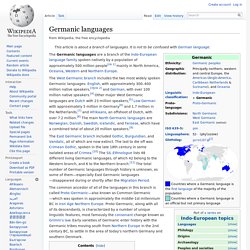
It is not to be confused with German language. The Germanic languages are a branch of the Indo-European language family spoken natively by a population of approximately 500 million people[nb 1] mainly in North America, Oceania, Western and Northern Europe. The West Germanic branch includes the two most widely spoken Germanic languages: English, with approximately 300–400 million native speakers,[3][nb 2] and German, with over 100 million native speakers.[4] Other major West Germanic languages are Dutch with 23 million speakers,[5] Low German with approximately 5 million in Germany[6] and 1.7 million in the Netherlands,[7] and Afrikaans, an offshoot of Dutch, with over 7.2 million.[8] The main North Germanic languages are Norwegian, Danish, Swedish, Icelandic, and Faroese, which have a combined total of about 20 million speakers.[9]
Faroese language. Faroese[2] (føroyskt, pronounced [ˈføːɹɪst]) is a North Germanic languages spoken as a native language by about 66,000 people, 45,000 of whom reside on the Faroe Islands and 21,000 in other areas, mainly Denmark.

It is one of four languages descended from the Old West Norse language spoken in the Middle Ages, the others being Norwegian, Icelandic, and the extinct Norn, which is thought to have been mutually intelligible with Faroese. [citation needed] Faroese and Icelandic, its closest extant relative, are not mutually intelligible in speech, but the written languages resemble each other quite closely, largely owing to Faroese's etymological orthography.[3] History[edit] The approximate extent of Old Norse and related languages in the early 10th century: Old West Norse dialect Old East Norse dialect. Icelandic language. Icelandic ( íslenska ) is a North Germanic language, the language of Iceland.
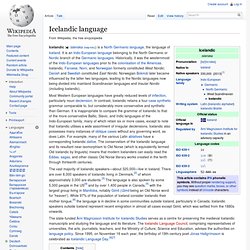
It is an Indo-European language belonging to the North Germanic or Nordic branch of the Germanic languages. Historically, it was the westernmost of the Indo-European languages prior to the colonisation of the Americas. Icelandic, Faroese, Norn, and Norwegian formerly constituted West Nordic; Danish and Swedish constituted East Nordic. Norwegian Bokmål later became influenced by the latter two languages, leading to the Nordic languages now being divided into mainland Scandinavian languages and Insular Nordic (including Icelandic).
Most Western European languages have greatly reduced levels of inflection, particularly noun declension. The vast majority of Icelandic speakers—about 320,000—live in Iceland. The state-funded Árni Magnússon Institute for Icelandic Studies serves as a centre for preserving the medieval Icelandic manuscripts and studying the language and its literature. History[edit] Phonology[edit] Bokmål. Bokmål ([ˈbuːkmɔːl], literally "book tongue") is an official written standard for the Norwegian language, alongside Nynorsk.

Bokmål is the preferred written standard of Norwegian for 85–90%[1] of the population in Norway, and is the standard most commonly taught to foreign students of the Norwegian language. [citation needed] Bokmål is regulated by the governmental Norwegian Language Council. A more conservative orthographic standard, commonly known as Riksmål, is regulated by the non-governmental Norwegian Academy for Language and Literature. The government does not regulate spoken Bokmål and recommends that normalised pronunciation should follow the phonology of the speaker's local dialect.[4] Nevertheless, there is a spoken variety of Norwegian that is commonly seen as the de facto standard for spoken Bokmål. Swedish language. Swedish ( svenska ) is a North Germanic language, spoken by approximately 8.7 million people worldwide,[1] predominantly in Sweden and parts of Finland, where it has equal legal standing with Finnish.

It is largely mutually intelligible with Norwegian and Danish (see Classification). Sranan Tongo. Sranan (also Sranan Tongo or Sranantongo "Surinamese tongue", Surinaams, Surinamese, Suriname Creole, Taki Taki) is a creole language spoken as a lingua franca by approximately 300,000 people in Suriname.[2] It was previously called nengre or in Dutch negerengels ("Negro English").

Since this language is shared between the Dutch-, Javanese-, Hindustani-, and Chinese-speaking communities, most Surinamese speak it as a lingua franca, both the Surinamese in Suriname, a former Dutch colony, as well as the immigrants of Surinamese origin in the Netherlands. Origins[edit] The Sranan words for 'to know' and 'small children' are sabi and pikin which is due to the Portuguese having been the first explorers of the West African coast, where they developed a pidgin language from which a few words became common coin in interactions with Africans by explorers who came afterward, including the English.
English language. English is a West Germanic language that was first spoken in early medieval England and is now a global lingua franca.[5][6] It is an official language of almost 60 sovereign states and the most commonly spoken language in sovereign states including the United Kingdom, the United States, Canada, Australia, Ireland, New Zealand and a number of Caribbean nations.
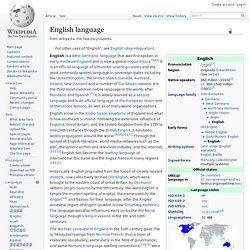
It is the third-most-common native language in the world, after Mandarin and Spanish.[7] It is widely learned as a second language and is an official language of the European Union and of the United Nations, as well as of many world organisations. English arose in the Anglo-Saxon kingdoms of England and what is now southeast Scotland. The Norman conquest of England in the 11th century gave rise to heavy borrowings from Norman French: thus a layer of elaborate vocabulary, particularly in the field of governance, and some Romance-language spelling conventions[17][18] were added to what had by then become Middle English.
Etymology. Frisian language. Frisian language may refer to: The Frisian languages, a closely related group of three Germanic languages: West Frisian language (fy), spoken in the Netherlands and often known there simply as the Frisian languageSaterland Frisian (frs), or East Frisian language, spoken in Lower Saxony, GermanyNorth Frisian language (frr), spoken in Schleswig-Holstein, GermanyEast Frisian Low Saxon, the West Low German dialect of East Frisia, Lower Saxony, Germany.

Flemish. "Vlaams" redirects here.
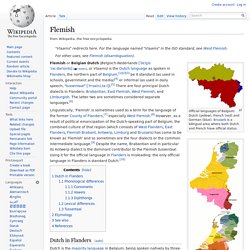
For the language named "Vlaams" in the ISO standard, see West Flemish. Official languages of Belgium: Dutch (yellow), French (red) and German (blue). Brussels is a bilingual area where both Dutch and French have official status. Afrikaans. Afrikaans /æfrɪˈkɑːns/[4] is a West Germanic language, spoken natively in South Africa and Namibia, and to a lesser extent in Botswana and Zimbabwe.
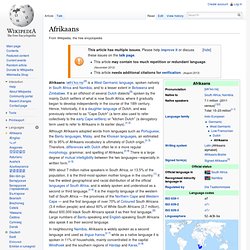
It is an offshoot of several Dutch dialects[5] spoken by the mainly Dutch settlers of what is now South Africa, where it gradually began to develop independently in the course of the 18th century. Hence, historically, it is a daughter language of Dutch, and was previously referred to as "Cape Dutch" (a term also used to refer collectively to the early Cape settlers) or "kitchen Dutch" (a derogatory term used to refer to Afrikaans in its earlier days).
[n 2] Dutch language. German language. German (Deutsch [ˈdɔʏtʃ]) is a West Germanic language that derives most of its vocabulary from the Germanic branch of the Indo-European language family.[9] Several German words are derived from Latin and Greek, and fewer are borrowed from French and English.